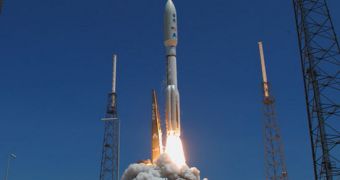The newest mission NASA created for exploring the largest planet in our solar system took off successfully yesterday, August 5, at 12:25 pm EDT (1625 GMT). The Juno spacecraft is heading for Jupiter, where it is scheduled to arrive in mis-2016.
The probe took off aboard an United Launch Alliance (ULA) Atlas V delivery system, from the Cape Canaveral Air Force Station (CCAFS), in Florida. Even if yesterday's planned launch were not successful, experts would have had an additional 21 days at their disposal in the launch window.
After reaching orbit and separating from its rocket, Juno was able to unfurl its solar panels and enter a trajectory that will take it towards the gas giant. Its main mission is to discover how the plane was formed, but also to analyze its composition and atmosphere.
Researchers believe that missions such as this one are the way to go if we want to understand how the solar system came to exist in its current configuration. A dedicated orbiter for Jupiter has been a long time coming, especially considering that Cassini has been studying Saturn for more than 7 years now.
“Jupiter is the Rosetta Stone of our solar system,” explains Scott Bolton. The expert – who holds an appointment at the San Antonio, Texas-based Southwest Research Institute (SwRI) – is the principal investigator of the Juno spacecraft.
The mission is managed by the NASA Jet Propulsion Laboratory (JPL), in Pasadena, California, Universe Today reports.
Jupiter “is by far the oldest planet, contains more material than all the other planets, asteroids and comets combined and carries deep inside it the story of not only the solar system but of us. Juno is going there as our emissary – to interpret what Jupiter has to say,” Bolton adds.
“We are going to be using a microwave detector and fly just over the clouds of Jupiter, looking down at different cloud depths to measure the amounts of water below. It’s a bit like doing a CT scan of Jupiter’s dense clouds,” Space quotes scientist Fran Bagenal as saying.
The University of Colorado expert is a Juno co-investigator on the new mission. The spacecraft also carries dual magnetometers, which it will use to create a high-definition view of the planet's magnetosphere. Experts say that this will allow them to understand the Jovian dynamo effect.
The gas giant has the most intense magnetic field of any object in the solar system other than the Sun.
“Today, with the launch of the Juno spacecraft, NASA began a journey to yet another new frontier. The future of exploration includes cutting-edge science like this to help us better understand our solar system and an ever-increasing array of challenging destinations,” NASA Administrator Charles Bolden said in a statement yesterday.

 14 DAY TRIAL //
14 DAY TRIAL //